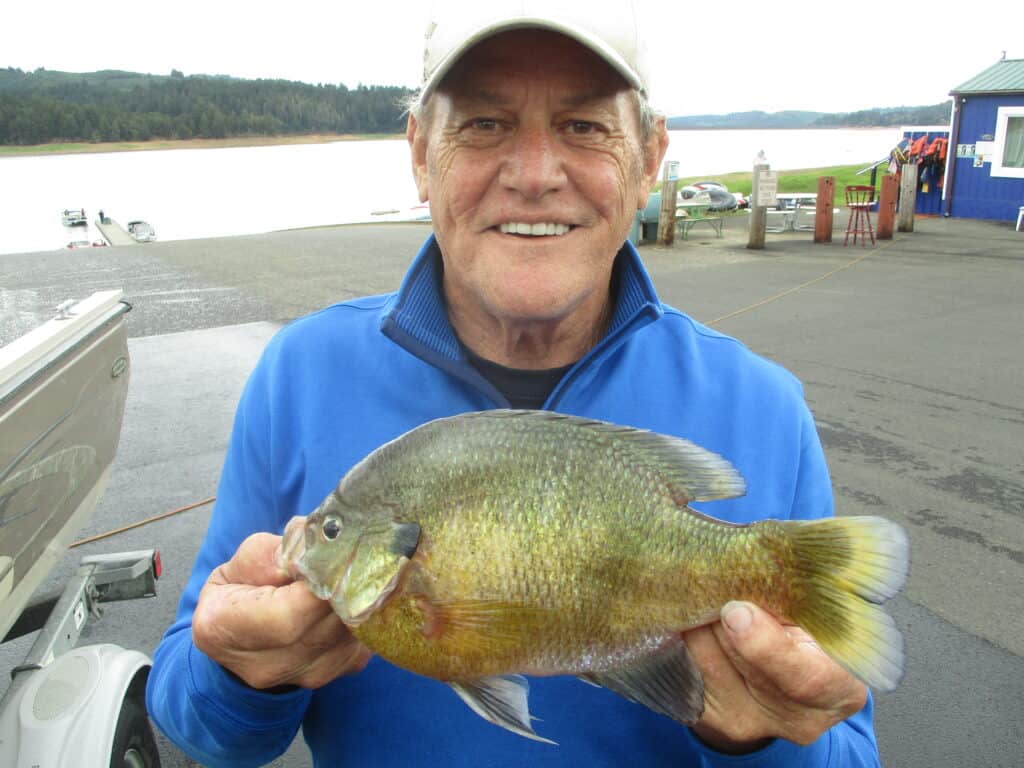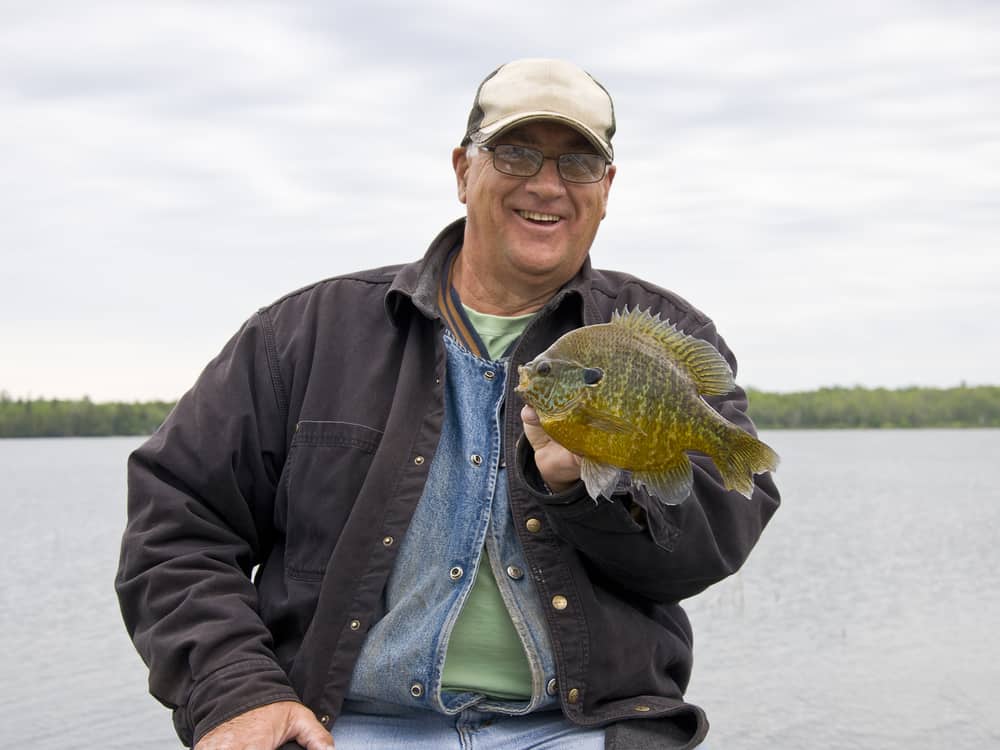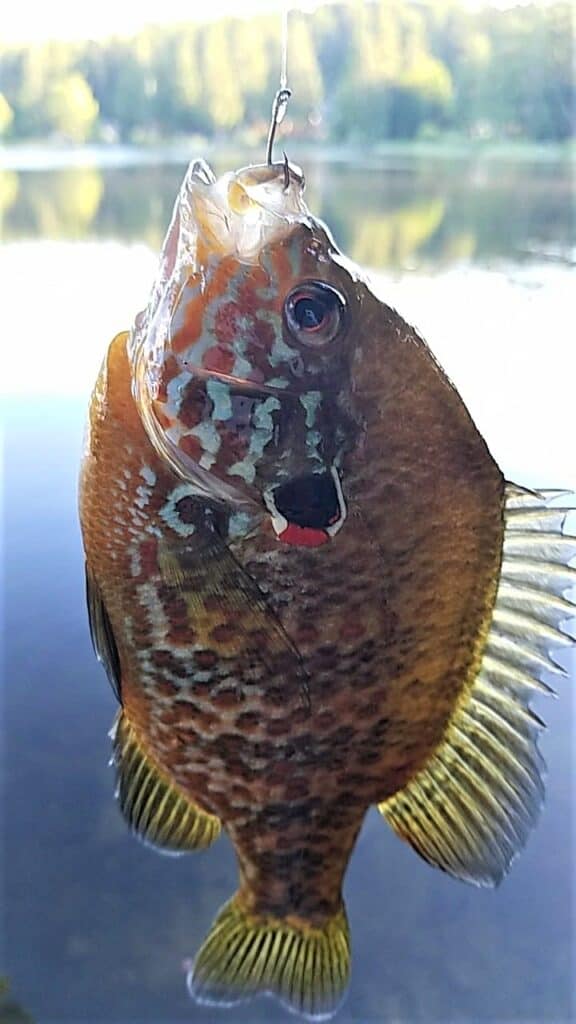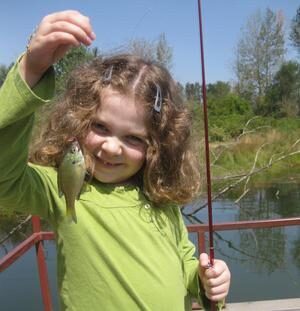Do you remember the first fish you ever caught? Chances are, it was a sunfish.
Bluegill and other sunfish species are some of the most common fish in waters across North America. They frequent ponds, weedy bays, backwaters, and slow-moving rivers and streams, where they can be caught using a wide range of tackle and techniques.
Despite their relatively small size—bluegill average about 4 to 8 inches in length—these fish can be great fun to catch. Bluegill put up a hard fight on light tackle, and they are also prized by many as tasty table fare.
The abundance of bluegill, along with their preference for shallow water and eager readiness to bite, make them favorites among amateur and experienced anglers alike.
How to Catch Bluegill and Sunfish
Many experienced sunfish anglers hone their technique to increase their catch or select for the largest bluegill. While simple bait fishing techniques are no doubt effective, it can also be rewarding to experiment with more advanced sunfish and bluegill fishing strategies.

But let’s be honest: Bluegill fishing can be as simple or as complex as you want it to be.
Along with other members of the sunfish family, bluegill have a reputation for biting nearly any small morsel that happens to cross their field of vision.
Bait Fishing for Bluegill and Sunfish
Live bait fishing is generally the simplest tactic for catching bluegill and other sunfish. As it happens, it’s often the most effective method as well.
Types of Live Bait for Bluegill and Sunfish
Many of us learned how to catch bluegill and sunfish with live bait when we were kids, and it’s a great way to introduce younger generations to fishing. Some of the most common baits for bluegill include:
Nightcrawlers
These are fairly large worms (often 6 inches or more) and where readily available they are among the most common sunfish baits. Most fishermen break them into small pieces, and thread one or two smaller segments of nightcrawler onto a small bait hook.
Red worms
The key difference between red worms and nightcrawlers is size; red worms are typically no more than 2 or 3 inches long, which is small enough that they can be used whole to catch bluegill. Often called red wigglers, that active habit helps make them irresistible to panfish.
Larvae baits
Sunfish typically eat very small morsels in their natural environment, which makes larvae baits (including mealworms, waxworms and grubs) highly effective. They are the most commonly used bait for ice fishermen but also work very well in warmer water.
Crickets
Many anglers swear by crickets as sunfish bait. They are most effective in summer, and should be hooked lightly through the thorax with a small hook so that the crickets stay alive and wiggling. You can fish them float on the surface of the water or sink them for deeper fish.
Live Bait Fishing Techniques
There are endless variations to live bait techniques for bluegill and sunfish, but most can be broken down into two categories: bottom fishing and bobber fishing.
It’s important to be open to both tactics. Simply let the conditions (along with the behavior of the fish) shape your approach.
Bottom Fishing
Common variations of bottom fishing for sunfish include a split-shot rig, which involves attaching one or two small split-shot sinkers to your line 6 to 12 inches above the bait; and a drop-shot rig, which involves attaching a bell sinker to the end of the line, usually about 12 inches below the bait.
Bobber Fishing
This is any technique that involves affixing a bobber or float to your line to keep the bait suspended above the bottom. Bobber fishing is especially effective to fish around weeds or other structures while avoiding snags, and it’s easy to see the bites when the bobber moves or disappears.
The distance between the bait and bobber can easily be adjusted depending on conditions, such as when you’re fishing over the top of a weed bed.

Lure and Jig fishing for Bluegill
Fishing with a jig or other type of lure is a more active tactic for bluegill and sunfish fishing, and as a result, some fishermen find it more enjoyable. Using artificial lures can also be a good way to avoid catching small bluegill, and instead focus on larger fish.
Jigs are the most popular style of lure for bluegill. Typical bluegill and sunfish jigs are made with a light jig head, to which may be attached any combination of hair, feathers or soft plastic intended to mimic the small aquatic creatures that sunfish eat.
Soft plastic jigs, such as tube jigs, are among the most popular. They allow you to quickly and easily switch colors and styles of lures to find the most effective presentation.
Fishing with lures and jigs is a great way to cover a lot of water more quickly, especially if you’re fishing from a small boat or kayak. This can help you find fish if you’re not sure where to start.
Fly Fishing for Bluegill
A large portion of bluegills’ diet consists of insects and insect larvae. This makes fly fishing a fun and effective way to pursue them, especially during spring and summer when many aquatic insects are breeding and hatching. Both dry and wet flies can be effective for bluegill.
Most fly fishermen choose flies that are a little bigger than what one might commonly use for finicky trout, but not as big as jumbo bass flies. Small streamers, large nymphs, wet flies, sinking bugs and poppers are all great choices.
Fly fishing allows you to fish relatively deep water while wading, and flies can effectively catch bluegill in weedy areas in which other lures would be easily snagged.
Sunfish Fishing Equipment and Tackle
Light tackle is best suited to sunfish and bluegill fishing. Light tackle allows you to cast small baits and lures farther and makes it easier to feel light bites. Plus, the lighter the tackle, the harder the fight of a fish feels, so light tackle can make fishing for bluegill more enjoyable.
Rods and Reels
Light or ultralight rods and reels in the 5- to 6-foot range work well for sunfish. Spinning rods are effective and user-friendly because they tend to be easy to cast and operate. Close-faced spinning reels, with a push-button release, are often the easiest for new anglers.
Fishing Line
Try to use the lightest line you can and match it to your rod and reel. For a light rod and reel, 4- to 8-pound test line can be used. For an ultralight setup, the line may be as light as 2-pound test, but be aware that line that light is more likely to break if fished around structures.
Hooks
Small bait hooks are ideal for bluegills’ tiny mouths. No. 6 to No. 10 hooks are usually just right, and long-shanked hooks are easiest to remove. Generally speaking, use smaller hooks that match up well with the size of your bait.
Lures and Jigs
In a nutshell, the smaller the lure, the better. Typical sunfish jigs weigh 1/32 to 1/16 ounce, though some may be as small as 1/64 ounce. Other types of lures such as spinners and spoons are usually most effective when they are an inch or less in length with smallish hooks.
Where to Catch Bluegill and Sunfish
Bluegill and sunfish inhabit lakes, ponds, reservoirs, rivers and streams throughout the United States. They typically prefer still or slow-moving water that warms up at least part of the year. Most sunfish species are native to areas east of the Rockies, but several including bluegill, are now widely available in most states.
Bluegill have even reached parts of Europe, where they are considered invasive. But while almost any body of water in the U.S. can have sunfish, it’s still important to know where to look.
Sunfish Habitat
Sunfish almost always relate to some sort of cover. Most often, that means aquatic vegetation. The edges of weed beds are often the best places to find bluegill, but they are often drawn to other types of cover as well, including submerged stumps and brush piles, fallen trees and rocky areas.
Areas that offer a mix of cover—a rocky drop-off leading to a weed bed, for example—are often best spots. Sunfish congregate around man-made-structures as well, including docks and piers, which they often seek out for shade and cover.
Depth
Sunfish are often thought of as shallow water fish. This is true, to an extent. In spring and summer especially, bluegill and other sunfish may commonly be found in just a few feet of water, but sunfish will also move between different depths depending on conditions and changes in season.
Larger bluegill in particular often seek out water greater than 10 feet deep during the hottest summer months, leaving their smaller relatives behind in the shallows.
A deeper weed bed located near a steep drop leading to shallower water is often a great spot to find the biggest bluegill in any given lake or pond.
Catching Sunfish in Current
Most types of sunfish don’t thrive in current the way they do in still water, but bluegill and other species do inhabit rivers and streams. In moving water, sunfish usually gravitate to areas where the current is not as strong, such as deep holes, along banks, backwaters, and broad flats.
As a general rule, if the current is slack enough to let weeds grow, there’s a good chance sunfish will congregate there. You’re more likely to find them in the broad, lower reaches of a river, not in rushing, cold mountain streams.
When to Catch Sunfish
Depending on location, sunfish bite readily at almost any time of year, which makes them popular among angers during all seasons, and in virtually every corner of the United States. Spring and summer are commonly thought of as prime fishing season for sunfish.
Bluegill Spawning Season
Bluegill typically spawn when water temperatures are around 70 degrees. Spawning seasons vary among different sunfish species, but most spawn at temperatures between 65 and 75 degrees. Nesting sites are often visible from shore in clear water.
During the spawn, bluegill dig gravelly, oval-shaped “nests” on shallow flats, where they fiercely defend their eggs until they hatch. The period immediately leading up to the spawn (pre-spawn) and following the spawn (post-spawn) are arguably the best seasons to fish for bluegill and other sunfish.
In the pre-spawn period, bluegill emerge from deep winter haunts and head toward warmer, food-rich shallow waters. Post-spawn, the biggest bluegills usually stay in shallow weed beds closest to spawning sites for a period of time, where they feed heavily and are often easy to catch.
Ice Fishing for Sunfish
The winter months can be some of the most productive for bluegill fishing in northern climates, provided you’re willing to brave the ice and snow. Bluegill often hang out in areas where green vegetation remains; look for weed beds near a significant drop off to find bluegill under ice.
Bluegill follow their food sources in winter, and as a result they gradually move toward deeper channels and basins as it gets colder.
They oftentimes suspend in deep water near structure in midwinter. As it gets closer to spring, they make their way back toward shallower bays.
Types of Sunfish in America
Taking the broadest definition of the word “sunfish,” there are 34 living species in North America (this includes crappie and black bass, all of which are technically classified as part of the sunfish family).
If you restrict the definition only to fish that are commonly referred to as sunfish, there are 13 recognized species. Some of the most common include:
Bluegill
In most parts of the United States, bluegill are the most common sunfish and the species most sought-after by anglers. Typically 4 to 8 inches in length, bluegill are usually olive-colored, often with vertical bars faintly visible up the sides.
Additional markings include a bluish tint around the lower jaw and gill cover, an orange blush to the chest area, and dark blue-to-black gill flaps lending them their name.
Bluegill have very small mouths relative to their body size, and they feed on a variety of small crustaceans, insects, insect larvae and worms.
Like most sunfish, their flattened body shape makes them best suited for still or slow-moving water, where they often congregate in weedy areas. Typically, the largest bluegills inhabit deeper water, leaving the shallows to smaller individuals.
Another very common name for bluegill in some parts of the U.S. is bream (or brim), or occasionally sunny or copper-nose.
Pumpkinseed Sunfish

Along with bluegill, pumpkinseed sunfish are among North America’s most abundant sunfish species. In some areas, particularly the Northeast states, they may even outnumber bluegill, and anglers often refer to them simply as sunfish, or common sunfish.
Pumpkinseed frequently share habitat with bluegill, but they can be easily identified by their vibrant coloration, which includes a bronze or bright orange belly, and wavy, irregular blue-green lines on the gill plates.
Pumpkinseed reach a similar size to bluegill, but tend to be a little smaller in waters where the two species compete.
Redear Sunfish
Although they have been introduced to waters across the United States, redear sunfish are native to the Southeastern United States, where local anglers often refer to them as shellcracker. Snails and mollusks are a large part of their diet (hence the nickname).
Redear sunfish are olive or bronze in color, with a distinctive red edge to the gill flaps.
Redear tend to grow slightly larger than bluegill and show a preference for deeper water. Bottom-oriented live bait fishing techniques tend to be the most effective way to catch them.
Rock Bass
True to their name, rock bass thrive in rocky habitats. They have large mouths and a mottled brown color that makes them look somewhat like a cross between a smallmouth bass and a sunfish, although they are more closely related to bluegill than sallies.
Rock bass bite readily on small lures and jigs, and often share habitat with smallmouth bass, leading some bass fishermen to consider them a nuisance.
They have large red eyes—earning them the nicknames “red-eye” and “goggle-eye” in some regions—which make them effective hunters during low-light conditions.
Redbreast Sunfish
Native to the Eastern United States and Canada, the redbreast sunfish is one of the most brightly-colored sunfish, with green to yellow-brown sides, a reddish-orange belly, red spots and blue-green streaks on its cheeks. They are generally a little smaller than bluegill.
The easiest way to identify a redbreast sunfish is usually by their extended gill flaps, which are entirely black.
Green Sunfish
One of the smallest sunfish species, green sunfish seldom exceed 6 inches long, although they have a relatively larger mouth than bluegill. With a more elongated body shape than most sunfish, they are better adapted to moving water, and they often inhabit weedy parts of streams.
Green sunfish are typically a blue-green color, marked by pale blue mottling on the sides of the head.

